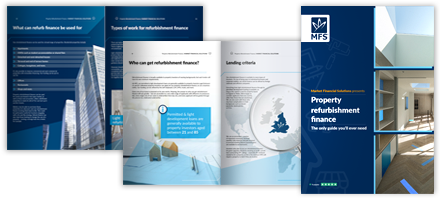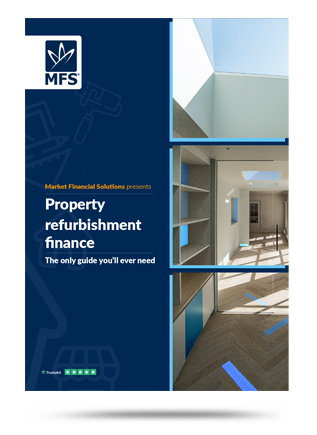Market Financial Solutions are a bridging loan and buy-to-let mortgage provider and are not legal, financial, investment or tax advisers. This document is for informational purposes only and does not, and should not be considered, to constitute legal, financial, investment or tax advice or be relied upon by any person to make a legal, financial, investment or tax decision. Therefore, Investors are encouraged to seek appropriate professional advice. The information in this content is correct at time of writing.

If a homeowner or property investor wants to make alterations to their assets, their options will likely be dictated by permitted development rights. These are a “national grant of planning permission which allow certain building works and changes of use to be carried out without having to make a planning application. Permitted development rights are subject to conditions and limitations to control impacts and to protect local amenity.”
Broadly, most people will need planning permission from a local authority if they want to:
- Build something new
- Make a major change to their building, such as building an extension
- Change the use of their building[1]
But, what about permitted development extension rules specifically? When it comes to improvements, most people will probably be engaging with some kind of extension. They’re likely to be much more straightforward (and cheaper) than a conversion project, or ground up development.
As such, it’s worth reminding ourselves of the rules around permitted development extensions, and the options that are available.
What Are The Rules, and When Is Permitted Development for an Extension Needed?
Broadly, some home extensions can be built without the need for full planning applications through permitted development rights[2]. This will save borrowers a lot of hassle and admin, although certain larger extensions may still need to follow the “prior approval” process[3].
Currently, there are a handful of extension types that can be done without needing to involve a local authority. This includes[4]:
- Single-storey extensions
- Double-storey extensions
- Loft conversions
- Porche extensions
- Garage extensions
- Conservatory extensions
- Garden room extensions[5]
- Kitchen extensions
Of course, the rules involved may vary from council to council on what can and can’t be done. To ensure one is on the right side of the rules, they should contact their local authorities for guidance. To help them on their way though, we’ll explore some of the most popular extension options.
Rear Extensions
Rear extensions involve extending the space at the back of a house, which typically involves a kitchen, or dining space[6]. This kind of extension can broadly be applied to any style of house, from semi detached brick properties through to period homes. Generally, if the rear extension is less than four meters, then it is unlikely to fall under the permitted development extension umbrella.

Side Extensions
Side extensions involve adding another room, or multiple rooms, onto the side of an existing building[7]. Different authorities will likely have individual rules on how large a side extension can be before planning permission is required.
Wraparound Extensions
A wraparound extension is essentially a hybrid of side and rear extensions. It will form an L-shape around the property, wrapping around two sides of the home[8]. This is one of the few house extensions that needs planning permission as it does not fall under permitted development tights. Those who want to pursue a wraparound extension will need to submit a householder planning application.
Single Storey
A single storey extension adds a storey to (usually) either the side or rear of a home. This is usually done to expand living spaces such as kitchens or dining areas[9]. According to resi[10], for a single storey extension to be permissible under permitted development rights:
- The size of the extension must not exceed half of the land area around the initial house. This covers the time since the property was built. As a result, one must factor in if any previous owners have carried out extension works in the land before
- The extension, after it’s built, must not be nearer to the public highway
- No part of the extension can exceed the highest part of the roof of the original house
- Its eaves and ridge height must not be higher than that of the existing house
- Materials used for the extension must be similar in appearance to the current house
- It cannot include a veranda, balcony, microwave antenna, chimney, flue, soil, and vent pipe.
- No alterations can be made to the roof of the existing house as well
Double Storey
As to be expected, a double storey extension is just a single storey plus one. Sometimes, they are known as two-storey extensions[11]. Under most circumstances, a double storey project will not be a permitted development extension, although there are some circumstances where the rights can come into play. According to Urbanist Architecture, for this to apply, the following criteria must be met:
- The double-storey extension can be a maximum of 3m deep – on both floors. So if one already has an extension that is more than 3m deep, they can’t build on top of it using permitted development
- The double-storey extension cannot be higher at the eaves than the existing eaves, or the roof of a double-storey extension should not be higher than the roof of the original house
- If the double-storey extension comes within two metres of the boundary of the owners land then the eaves cannot be taller than three metres
- The double-storey extension cannot also include any balconies, verandas, raised platforms, microwave antenna, chimneys, or involve any alteration to the existing house’s roof
- The materials used on the outside of the new double-storey extension should match the materials used on the outside of the existing house
- Similarly, the roof pitch of the double-storey extension should match the roof pitch of the original house as closely as possible
- The land used for the double-storey extension should not be within seven metres of any land boundary or extend beyond the rear wall of the original building by more than three metres
- If a person is building a side elevation and wants to put a window on the first floor, it should be obscure-glazed and non-opening unless the openable part is higher than 1.7 metres from the room’s floor
Over-structure Extension
An over-structure extension is one that is built over the top of an existing structure, such as a garage[12]. They are typically done by those who would like to extend their home while preserving garden space. Generally, over-structure extensions may not require planning permission [13]but, as with any extension project, it is best to speak with the local planning department for guidance.
Understanding permitted development extensions rules essential, given how much of an impact these projects can have. According to Check a Trade[14], the average cost for a 20 m2 extension is nearly £50,000. But, this cost may prove worth it, considering a house extension can add up to 20% to its value.
Where property investors need financial support for their permitted development side extension, permitted development for rear extensions, or even a permitted development conservatory project – Market Financial Solutions will be there with tailored funding at the ready.
The Complete Guide to
Refurbishment Finance
Everything you need to know
- Basics of refurbishment
- Different finance types
- Lending criteria & calculator
- Real life case studies
[1] https://www.gov.uk/planning-permission-england-wales
[2] https://www.merton.gov.uk/planning-and-buildings/permitted-development-and-prior-approval
[3] https://www.planningportal.co.uk/planning/planning-applications/consent-types/prior-approval
[4] https://www.purplebricks.co.uk/property-guides/sellers/extend-home-without-planning-permission
[5] https://www.which.co.uk/news/article/6-home-renovations-that-dont-need-planning-permission-aWNn22l76Tzz
[6] https://www.create-spaces.co.uk/home-extensions/rear-house-extensions-london
[7] https://urbanistarchitecture.co.uk/side-extension/
[8] https://urbanistarchitecture.co.uk/wraparound-extension/
[9] https://bespokeconstructiongroup.co.uk/extensions/single-storey-extension/#:~:text=Side%20Single%20Storey%20Extensions&text=These%20extensions%20are%20perfect%20for,matching%20exteriors%20with%20similar%20materials.
[10] https://resi.co.uk/advice/single-storey-extension/planning-permission-for-single-storey-extension
[11] https://urbanistarchitecture.co.uk/double-storey-extension/
[12] https://resi.co.uk/advice/house-extensions/house-extensions-types
[13] https://www.checkatrade.com/blog/cost-guides/cost-of-extension-over-garage/
[14] https://www.checkatrade.com/blog/cost-guides/house-extension-cost/






